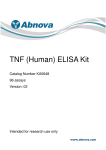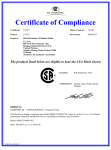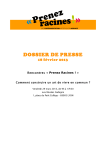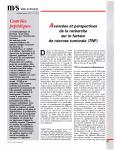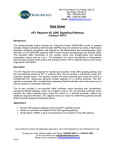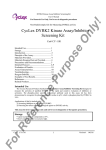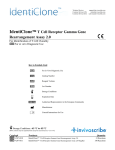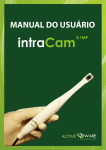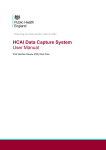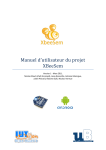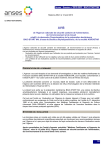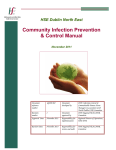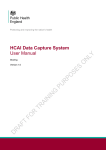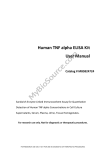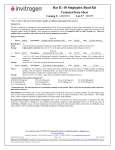Download Human TNF-a
Transcript
AviBion Human TNF-α ELISA Kit User Manual : TNFa021 96 Regulatory Status: For research use only (RUO) Please contact Orgenium’s customer service representatives for inquiries, feedback or about non-conforming products. Orgenium Laboratories Viikinkaari 6 FIN-00790 Helsinki FINLAND Tel : +358-9-319 36450 Fax +358-20-781 8175 www.orgenium.com [email protected] AviBion Human TNF-α ELISA 1/17 Rev02.08 TABLE OF CONTENTS 1. INTENDED USE………………………………………………………………………3 2. INTRODUCTION……..……………………………………………………………....3 3. CONTENTS OF THE KIT.………………..…………………………………………..4 4. STORAGE AND STABILITY…………………………………………………………5 5. ADDITIONAL MATERIALS REQUIRED…………..…………................................6 6. AMOUNT OF THE REAGENTS NEEDED TO PERFORM THE TEST………… 6 7. REAGENT AND SAMPLE PREPARATION……………………………………… .7 8. TEST PROCEDURE SUMMARY ………………………………................................9 9. PROCEDURAL NOTES………………………………………………………………10 10. ASSAY PROCEDURE ……………………................................................................12 11. CALCULATION OF RESULTS…………………………………………………….13 12. TYPICAL DATA……………………………………………………………………...14 13. TEST PERFORMANCE………………………………………. ……………………15 14. REFERENCES…………………………...……………………………………………16 15. TROUBLESHOOTING GUIDE.…..……………...………………………………….17 AviBion Human TNF-α ELISA 2/17 Rev 2.08 1. INTENDED USE Orgenium Laboratories’ TNF-α ELISA is an enzyme-linked immunosorbent assay for quantitative detection of human TNF-α in cell culture supernatants, human plasma (EDTA, heparin and citrate), serum, cerebrospinal fluid, urine, synovial fluid or other body fluids. The assay will recognize both natural and recombinant Hu TNF-α. 2. INTRODUCTION Tumor Necrosis Factor- α (TNF- α) is a non-glycosylated 17.5 kDa, 157 amino acid protein. TNF- α is a potent lymphoid factor and exerts cytotoxic effects on a wide range of tumor cells and other target cells. It is secreted by macrophages, monocytes, neutrophils, Tcells, and NK-cells following their stimulation by bacterial lipopolysaccharides. TNF-α has been suggested to play a pro-inflammatory role and has been detected in synovial fluid of patients with rheumatoid arthritis. Various pathological conditions are associated with the production of high levels of TNF-α. These include septic shock, cachexia (e.g. HIV, tuberculosis, cancer), autoimmune diseases, hepatitis, leukemia, myocardialischaemia, organ transplantation rejection, multiple sclerosis, rheumatoid arthritis, and meningococcal septicemia. Annually, many people die from septic shock syndrome, triggered by TNF-α following complications from an infectious disease. In many cases elevated TNF-α serum levels predict a higher mortality. Orgenium Laboratories’ human TNF-α ELISA kit is an in vitro enzyme-linked immunosorbent assay for the quantitative measurement of human TNF-α in cell culture supernatants, serum, plasma, cerebrospinal fluid, urine, synovial fluid and other body fluids. This assay employs an antibody specific for human TNF-α coated onto a 96-well plate. Standards, samples and biotinylated anti-human TNF-α are pipetted into the wells. TNF-α present in a sample is captured by the antibody immobilized to the wells and by the biotinylated TNF-α specific detection antibody. After washing away unbound biotinylated antibody, HRP-conjugated streptavidin is pipetted to the wells. The wells are again washed. Following the second wash step, TMB substrate solution is added to the wells, resulting in color development proportional to the amount of TNF-α bound. The Stop Solution changes the color from blue to yellow, and the intensity of the color is measured at 450 nm. AviBion Human TNF-α ELISA 3/17 Rev 2.08 3. CONTENTS OF THE KIT Test components Amount/Volume 96 Well Plate with 12 Strips Break apart microtiter test strips each with TNF-α antibody coated single wells Ready for use 1 frame TNF-α Standard Lyophilized & Stabilized Recombinant Human TNF-α (see label for stock concentration) Add 1 ml of “Sample Diluent” before use. 2x1ml Biotinylated TNF-α antibody Ready for use. 12 ml HRP-Conjugated Avidin Ready for use. 12 ml 20x Washing solution concentrate (sufficient for 1000ml) Dilute 1:20 50 ml Dilution buffer Ready for use 100 ml Stop solution 2 N H2SO4 Ready for use 8 ml TMB-Substrate Ready for use 8 ml Quality Control Certificate 1 AviBion Human TNF-α ELISA 4/17 Rev 2.08 4. STORAGE AND STABILITY Reagent TNF-α antibody coated 96 well plates with 12 strips. Storage Store at 2-8°C in closed aluminum bag with desiccant Break apart microtiter test strips each with 8 antibody coated single wells Strips which are not used must be stored in the resealable aluminum bag in humidity free and airtight conditions Store at 2-8°C TNF- alpha Standard Lyophilized Biotinylated antibody. Ready for use. HRP-Conjugated Avidin. Ready for use. Sample Diluent 20x Concentrated Wash Buffer Diluted Wash Buffer TMB-Substrate Solution Stop Solution Store at 2-8°C Avoid contamination (Use clean sterile tips) Store at 2-8°C Avoid contamination (Use clean sterile tips) Store at 2-8°C Avoid contamination (Use clean sterile tips or pipettes) Store at 2-8°C To avoid crystal formation, wash buffer concentrate, may also be stored at Room Temperature. 1x working dilution Bottles used for the working dilution should be cleaned regularly, discard cloudy solutions Store at 2-8°C, protected from light! Avoid contamination (Use clean sterile tips) Store at 2-8°C. May also be stored at Room Temperature AviBion Human TNF-α ELISA 5/17 Rev 2.08 Stability 3 months after opening Until date of kit expiry in lyophilized format. At least 3 weeks after dissolving with sample diluent. 3 months after opening 3 months after opening 3 months after opening Until expiry date 1 week at room temperature or one month at 2-8 °C Until expiry date Until expiry date at room temperature 5. ADDITIONAL MATERIALS REQUIRED • Microplate reader capable of measuring absorbance at 450 nm. • Precision pipettes to deliver 2 µl to 1 ml volumes. • Multi-channel pipet (25 µl to 350 µl). • Adjustable 1-25 ml pipettes for reagent preparation. • 100 ml and 1 liter graduated cylinders. • Absorbent paper. • Distilled or de-ionized water. • Log-log graph paper or computer and software for ELISA data analysis. • Tubes to prepare standard or sample dilutions. • Timer 6. AMOUNTS OF THE REAGENTS NEEDED TO PERFOM THE TEST Reagents No of strips used (with 8 well each) Biotinylated antibody 50 µl/well Avidin-HRP 50µl/well TMB substrate Stop Solution 50 µl/well 25 µl/well Wash Buffer 300 µl/well 1 (8 wells) 500 µl 500 µl 500 µL 300 µl 30 ml 2 (16 wells) 1 ml 1 ml 1 ml 600 µL 55 ml 4 (32 wells) 2 ml 2 ml 2 ml 1.2 ml 110 ml 6 (48 wells) 3 ml 3 ml 3 ml 1.8 ml 165 ml 8 (64 wells) 4 ml 4 ml 4 ml 2.4 ml 220 ml 12 (96 wells) 6 ml 6 ml 6 ml 4 ml 350 ml AviBion Human TNF-α ELISA 6/17 Rev 2.08 7. REAGENT AND SAMPLE PREPARATION Note: All reagents and samples must be allowed to equilibrate to room temperature (1825°C) before use. 1. Antibody coated plate: Before opening the foil pouch, determine the number of strips required to test the desired number of samples, plus 16 wells needed for running standards and blanks in duplicate. Remove non-used strips from the plate-frame and return them to the foil pouch containing the desiccant for up to 3 months at 2-8°C. 2. Dilution of test standard: Dissolve the lyophilised TNF-α standard with 1 ml of "Sample Diluent". TNF-α standard is stable for at least 3 weeks after dissolving. To obtain a standard curve dilute it as follows: 1. Take 300 µl of TNF-α standard from kit standard tube containing 250 pg/ml of TNF-α and pipette into Standard tube 1. 2. Add 150 µl of Sample Diluent to all other 6 dilution tubes. Take 150 µl from the first tube (250 pg/ml) and start 2 fold serial dilutions in dilution tubes as described in the figure by mixing several times with the pipet in each tube (Total of 7 dilution tubes). c) 150 µl of sample Diluent serves as zero standard (0 ng/ml) in tube 8. 300 µl of TNF-α Standard (250 pg/ml) 150µl 150µl 2 250 pg/ml 125 pg/ml 62.5 pg/ml 150µl Sample Diluent as a blank 15.6 pg/ml AviBion Human TNF-α ELISA 7/17 Rev 2.08 150µl 150µl 150µl 31.25 pg/ml *Only 150 µl of 7.8 pg/ml 3.9 pg/ml 0 pg/ml 3. Sample preparation and dilution: Dilution of samples is not required for initial screening. Samples that exceed the measuring range should be diluted in sample diluent serially 1:2, 1:4, or further if necessary, and measured again. The dilution factor must be taken in account when calculating the results. Dilute and store all samples in tubes or plates made of material with low binding surface, such as polypropylene. 4. Sample collection and storage: Serum, EDTA, heparin or citrate anti-coagulated plasmas, cerebrospinal fluid, urine, synovial fluid, other body fluids and cell culture supernatants are suitable for use in the assay (caution: separate plasma/serum and blood cells within 4 hours after collection, non-separated samples must be kept at 28°C). Do not use grossly haemolysed or lipemic specimens. If samples are to be run within 24 hours, they may be stored at 2-8°C; otherwise samples should be stored frozen (at least between -18 to -32°C, but preferably < -70°C). Up to 3 freeze-thaw cycles have no effect on the TNF-α levels of samples. Nonetheless, excessive freeze-thaw cycles should be avoided. Prior to the assay, frozen samples should be thawed as quickly as possible in tap water (18-25°C), do not use 37°C or 56°C water bath for this purpose. 5. Preparation of reagents: a. Wash Buffer: If the 20x concentrated Wash Buffer contains visible crystals, warm it at 37°C and mix gently until dissolved. Dilute 1:20 with de-ionized or distilled water (e.g. 25 ml of Wash Buffer Concentrate and 475 ml distilled water to yield 500 ml of 1x Wash Buffer). Check the pH of the diluted wash buffer and adjust to 7.4 if necessary. b. Vortex mix Biotinylated antibody solution gently before use. c. Vortex mix peroxidase (HRP) labeled avidin gently before use. Caution: TMB substrate (Tetramethylbenzidine) and the Stop solution (H2SO4) are toxic or corrosive and should be handled with care. Use gloves during handling. AviBion Human TNF-α ELISA 8/17 Rev 2.08 8. TEST PROCEDURE SUMMARY 1. Prepare all reagents, samples and standards. Dilution of samples not required at initial screening. 2. Add 50 µl standard (starting from 250 pg/mL), test samples and sample diluent as a blank into the appropriate wells of the strips. Incubate 1 hour at room temperature. Wash 5x. 3. Add 50 µl ready for use biotin antibody promptly to each well. Incubate 30 min. at room temperature. Wash 5x. 4. Add 50 µl ready for use HRP-Streptavidin solution. Incubate 30 minutes at room temperature. Wash 5x. 5. Add 50 µl TMB Substrate Solution to each well. Incubate 20 minutes at room temperature. 6. Add 25 µl Stop Solution to each well. Read at 450 nm against *630 nm immediately. Subtract blank values from values for standards and test samples *Correcting for optical imperfections in the microplates by subtracting A630 nm is recommended, but not an essential procedure. AviBion Human TNF-α ELISA 9/17 Rev 2.08 TEST PRINCIPLE TNF-α Antibody coated test well STEP 1 Add 50 µL of standards and test samples to test well and incubate 1 hr at Room Temperature STEP 2 Add 50 µL of Biotinylated TNF-α antibody to test well and incubate 30 min. at Room Temperature TNF-α Biotinylated TNF-α Add 50 µL of HRP-Streptavidin to test well and incubate 30 minutes at Room Temperature STEP 3 TNF-α antibody HRP-Streptavidin STEP 4 Add 50 µL of TMB substrate to test well incubate 20 minutes at Room Temperature TMB substrate AviBion Human TNF-α ELISA 10/17 Rev 2.08 9. PROCEDURAL NOTES/LAB QUALITY CONTROL • When not in use, kit components should be refrigerated. All reagents should be warmed to room temperature before use. • Microtiter plates should be allowed to come to room temperature before opening the foil bags. • Once the desired number of strips has been removed, immediately return unused strips to the bag, reseal the bag and store at +2 - 8°C to maintain plate integrity. Protect from humidity. • Samples should be collected in pyrogen/endotoxin-free tubes. • Samples should be frozen if not analyzed shortly after collection. Avoid multiple freeze-thaw cycles of frozen samples. Thaw completely and mix well prior to analysis. • When possible, avoid the use of badly hemolyzed or lipemic sera. If large amounts of particulate matter are present, centrifuge or filter prior to analysis. • It is recommended that all standards, controls and samples are run in duplicate. • Samples that are above the detection limit should be diluted with sample diluent. • When pipetting reagents, maintain a consistent order of addition from well-to-well. This ensures equal incubation times for all wells. • Cover or cap all reagents when not in use. • Do not use reagents past their expiration date. • Read absorbencies within 20 minutes of assay completion. • In-house controls should be run with every assay. If control values fall outside preestablished ranges, the accuracy of the assay is suspect. • All residual wash buffer must be drained from the wells by efficient aspiration or by decantation followed by tapping the plate forcefully on absorbent paper. Never insert absorbent paper directly into the wells. • Because TMB substrate solution is light sensitive, avoid prolonged exposure to light. Also avoid contact between TMB substrate solution and metal, or color may develop. AviBion Human TNF-α ELISA 11/17 Rev 2.08 10. ASSAY PROCEDURE 1. Bring all reagents and samples to room temperature (18 - 25°C) before use. It is recommended that all standards and samples be run at least in duplicate. Leave some wells as a reagent blank (2 to 4 wells). FIRST STEP: STANDARD, SAMPLES AND BLANK+ BIOTINYLATED ANTIBODY 2. Pipette 50 µl of sample and 50 µl of each diluted standard starting from 250 pg/mL (see page 7) into appropriate wells. Pipette 50 µl of sample diluent to the wells which will be used as a blank. Incubate 1 hr at room temperature without shaking. SECOND STEP: BIOTINYLATED ANTIBODY 3. Wash 5x with 1x Wash Solution (300 µl each) To wash manually: Empty plate contents. Use a multi-channel pipette to fill each well with 300 µl of diluted wash buffer, then empty plate contents again. Repeat procedure 4 additional times for a total of FIVE washes. Gently blot plate onto paper towels or other absorbent material. Never let reaction wells dry. Continue to the next step without delay or interruption. For automated washing: Aspirate all wells and wash 5 times with 300 µl diluted wash buffer. Blot plate onto paper towels or other absorbent material. Never let reaction wells dry. Continue to the next step without delay or interruption. 4. Promptly add 50 µl of green colored Biotinylated TNF-alpha detection antibody to all wells. Tap the plate gently by hand to homogenize your mixture. Avoid touching to the reaction wells with the pipette tip. Incubate at room temperature for 30 minutes without shaking. THIRD STEP: HRP-CONJUGATED AVIDIN 5. Wash 5 times 5x as described in Step 3. Add 50 µl of prepared HRP-conjugated avidin solution (ready to use) to each well. Incubate for 30 minutes at room temperature. FOURTH STEP: TMB SUBSTRATE 6. Wash 5 times as described in Step 3. 7. Using a multichannel pipette, promptly add 50 µl of TMB ready to use substrate reagent to each well. Incubate for 20 minutes at room temperature in the dark. 9. Add 25 µl of Stop Solution to each well. Read at 450 nm within 15 minutes. Correcting for optical imperfections in the microplates by subtracting A630 nm is recommended, but not an essential procedure. AviBion Human TNF-α ELISA 12/17 Rev 2.08 FIFTH STEP: READING AND CALCULATION 10. Calculate the mean of reagent blank absorbance values and subtract it from all test well values (standard and test samples). Mean reagent blank absorbance value at 450 nm should be less than 0.200. 11. Calculate your results against standard curve, as outlined below. 11. CALCULATION OF RESULTS The standard curve must be determined individually for each experiment. Correct the absorbance values of all standards by subtracting from them the mean O.D. value of the reagent blank (Bl = only sample diluent). Calculate the mean absorbance value for each standard from the duplicates. The standard curve is used to determine the amount of TNF alpha in an unknown sample. The standard curve is generated by plotting the average O.D. (450 nm) obtained for each of the standard concentrations on the vertical (Y) axis versus the corresponding TNF alpha concentration (pg/mL) on the horizontal (X) axis. Construct the standard curve using graph paper or statistical software. If samples generate values higher than the highest standard, dilute the samples with sample diluent and repeat the assay. Note that the concentration read from the standard curve must be multiplied by the dilution factor. AviBion Human TNF-α ELISA 13/17 Rev 2.08 12. TYPICAL DATA The following standard curve is obtained for various concentrations of TNF-α standard over the range of 0 to 250 pg/mL. Please note: The curve is provided for illustration only. A standard curve should be generated each time the assay is performed. 2,5 Absorbance @450 2 1,5 1 0,5 0 0 50 100 150 200 TNF-alpha Standard pg/ml AviBion Human TNF-α ELISA 14/17 Rev 2.08 250 300 13. TEST PERFORMANCE TNF-α Assay range 3.9-250 pg/ml Standard curve points 250, 125, 62.5, 31.25, 15.62, 7,8, 3.9 and 0 pg/ml. Intra-Assay-Precision <6% Inter-Assay-Precision <4% Inter-Lot-Precision <8% Cross-Reactivity Interferences No cross reactivity was observed with the following recombinant human proteins: IL-1ß, IL-1α, IL-2, IL-3, IL-4, IL-5, IL-6, IL-7, IL-8, IL-9, IL-10, IL-12, IL-13, TARC No interferences to bilirubin up to 0.3 mg/mL, haemoglobin up to 8.0 mg/mL and triglycerides up to 5.0 mg/mL Specificity Recognizes both natural and recombinant human TNF-α. Sensitivity <4 pg/ml Expected values in healthy individuals Expected values in infection suspected individuals TNF-alpha serum levels in healthy controls was found between 1 to 4 pg/ml >6 pg/ml The average amount of TNF-α in patients with a respiratory tract infection with an unknown cause was with Orgenium’s TNF-α ELISA kit found to be 40 pg/ml (range between 6 to 380 pg/ml). TNF-α levels may vary greatly between different study groups and sample types (such as serum samples, cell culture supernatant, cell extracts or other biological samples). Each research study should include a proper control group (age, sex, locality or geographical region matched) to establish more precise TNF-α values. Disease status or the use of drugs or TNF-α stimulating agents may interfere with the TNF-α levels and should be taken into careful consideration in all studies. AviBion Human TNF-α ELISA 15/17 Rev 2.08 14. REFERENCES 1. Seriolo B, Paolino S, Sulli A, Fasciolo D, Cutolo M.(2006). Effects of anti-TNFalpha treatment on lipid profile in patients with active rheumatoid arthritis. Ann N Y Acad Sci. 1069:414-9. 3. Intiso D, Zarrelli MM, Lagioia G, Di Rienzo F, Checchia De Ambrosio C, Simone P, Tonali P, Cioffi Dagger RP. (2004). Tumor necrosis factor alpha serum levels and inflammatory response in acute ischemic stroke patients. Neurol Sci. 24:390396. 4. Beutler, B. et al. (1987) Cachectin: more than a tumor necrosis factor. N. Engl. J. Med. 316:379-385. 5. Tracey, K.J. et al. (1987) Anti cachectin/TNF monoclonal antibodies prevent septic shock during lethal bacteraemia. Nature 330:662-664. 6. Piguet, P.F. et al. (1987) Tumor necrosis factor/cachectin is an effector of skin and gut lesions of the acute phase of graft-versus-host 7. disease. J. Exp. Med. 166:1280-1289. 8. Aukrust, P. et al. (1994) Serum levels of tumor necrosis factor-α (TNF-α) and soluble TNF receptors in human immunodeficiency virus type 1 infectioncorrelations to clinical immunologic, and virologic parameters. J. Inf. Dis. 169:420424. 9. Waage, A. et al. (1987) Association between tumor necrosis factor in serum and fatal outcome in patients with meningococcal disease. Lancet 1:355-357. 10. Noraz, N. et al. (1997) Human cytomegalovirus-associated immunosuppression is mediated through IFN-α. Blood 89(7):2443-2452. 11. Lekutis, C. et al. (1998) HIV-1 env DNA vaccine administered to rhesus monkey elicits MHC class II-restricted CD4+ T helper cells that secrete IFN-γ and TNF-α. J. Immunol. 158:4471-4477. 12. Neuman, M.G. et al. (1998) Role of cytokines in ethanol-induced cytotoxicity in HepG2 cells. Gastroenterology 114(7):157-169. 13. Dong, Z. et al. (1998) Activation of cytokine production, tumoricidal properties, and tyrosine phosphorylation of MAPKs in human monocytes by a new synthetic lipopeptide, JBT3002. J. Leukocyte Biol. 63:766-774. 14. Murato, P.A. et al. (1997) Immunodominance of a low-affinity major histocompatibility complex-binding myelin basic protein epitope (Residues 111129) in HLA-DR4 (B1*0401) Subjects is associated with a restricted T cell receptor repertoire. J. Clin. Invest. 100(2):339-349. 15. Ludviksson, B.R. et al. (1998) Active Wegener’s granulomatosis is associated with HLA-DR+ CD4+ T cells exhibiting an unbalanced Th1-type T cell cytokine pattern: Reversal with IL-10. J. Immunol. 160:3602-3609. AviBion Human TNF-α ELISA 16/17 Rev 2.08 15. TROUBLE SHOOTING Problem Cause Poor standard Curve Low signal Solution 1. Inaccurate pipetting or pipetting error Check pipettes and calibrate regularly. 2. Improper standard dilution Vortex the stock before use and dilute carefully in an eppendorf tube. 1.Shorter incubation than recommended Ensure sufficient incubation time; 2. Inadequate reagent volumes or improper dilution or pipetting error Check pipettes and ensure correct performance. Large CV Inaccurate pipetting and drying of Check pipettes wells during test procedure. Fill the wells promptly with wash buffer and reagents. High background 1. Plate is insufficiently washed 2. Contaminated wash Buffer 3. Wash buffer volume is less than advised Review the manual for proper wash. If using a plate washer, check that all ports are unobstructed and clean. Make a fresh wash buffer Use 300µl per well Low sensitivity 1. Improper storage of the ELISA kit Store test kit components as advised in this user manual. Keep substrate solution protected from light. 2. Stop solution Stop solution should be added to each well before measure. 3. Contamination of reagents AviBion Human TNF-α ELISA 17/17 Rev 2.08 Use clean sterile tips. Discard contaminated reagents.

















